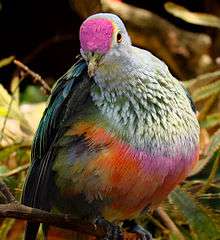Sea Acres National Park
| Sea Acres National Park New South Wales | |
|---|---|
|
IUCN category II (national park) | |
|
Boardwalk at Sea Acres | |
 Sea Acres National Park | |
| Nearest town or city | Port Macquarie |
| Coordinates | 31°27′50″S 152°55′53″E / 31.46389°S 152.93139°ECoordinates: 31°27′50″S 152°55′53″E / 31.46389°S 152.93139°E |
| Established | 11 March 1987[1] |
| Area | 0.76 km2 (0.3 sq mi)[1] |
| Managing authorities | NSW National Parks and Wildlife Service |
| Website | Sea Acres National Park |
| See also |
Protected areas of New South Wales |
The Sea Acres National Park is a protected national park that is located in the Mid North Coast region of New South Wales, in eastern Australia. The 76-hectare (190-acre) park is situated near the town of Port Macquarie. The park is a popular tourist area with a 1.3-kilometre (0.81 mi) long boardwalk through a remnant of seaside rainforest. There is also an education centre and cafe. The park was initially declared as a nature reserve in 1987; and gazetted as a national park in October 2010.[2]
Features
Fauna
Recorded within the reserve are over a hundred types of bird species. Rare species include the wompoo fruit-dove, rose-crowned fruit-dove and osprey. Reptiles include the lace monitor, land mullet and the diamond python. Twenty-one species of mammals have been recorded in the national park, including koala, spotted-tail quoll and the little bent-wing bat. Two rare types of snail are known here.[3]
Flora
Sea Acres National Park contains one of the largest and most intact segments of coastal rainforest in New South Wales.[4] The remnant rainforest area adjacent to Shelley Beach is noteworthy as much of this sea side of forest has been cleared for agriculture, mining or housing. Common species of tree include tuckeroo, coogara, red olive berry, white walnut, flintwood, strangler fig, sour cherry, Francis watergum, maiden's blush and mock olive.[5]
Vines are common; they include lawyer vine, supplejack, and water vine. Walking stick palms and Bangalow palms are often seen. Epiphytes are common in the taller more protected areas; such as the staghorn and elkhorn ferns. The hare's foot fern is an interesting climbing plant in the rainforest. The taller areas in the gully may be considered more sub-tropical rather than littoral rainforest.[5]
The widespread sea hibiscus is found at its southernmost limit of natural distribution at Sea Acres. Another similarly widespread coastal plant is also found at or very close to its southern limit, the screw pine. This plant is usually associated with Pacific Islands in the tropics. The rainforest botanist A.G. Floyd suggests that Sea Acres and similar beachside rainforests near Port Macquarie may be botanical refugia from a warmer period.[5][6]
There are also non-rainforest areas which include grassland, banksia woodland and eucalyptus forest with tallowwood, blackbutt, and Sydney blue gum.[7]
Weeds and pests
There are infestations of lantana, morning glory and bitou bush in the park. Dumping of garden refuse makes the problem worse. Feral dogs, foxes, and cats have an impact upon local wildlife.[4]
Gallery
See also
References
- 1 2 "Sea Acres National Park: Park management". Office of Environment and Heritage. Government of New South Wales. Retrieved 26 September 2014.
- ↑ "Sea Acres National Park: History since colonisation". Office of Environment & Heritage. Government of New South Wales. Retrieved 7 August 2012.
- ↑ "Sea Acres National Park: Native animals". Office of Environment & Heritage. Government of New South Wales. Retrieved 8 August 2012.
- 1 2 "Sea Acres National Park: Pest animals and weeds". Office of Environment & Heritage. Government of New South Wales. Retrieved 11 September 2012.
- 1 2 3 Floyd, A. G. (1990). Australian Rainforests in New South Wales. 2. pp. 55, 60. ISBN 0-949324-32-9.
- ↑ Sea Acres Rainforest Centre. Department of Environment & Conservation (pamphlet). Government of New South Wales. 2005.
- ↑ "Sea Acres National Park: Native vegetation". Office of Environment & Heritage. Government of New South Wales. Retrieved 11 September 2012.
External links
- "Sea Acres Nature Reserve: Plan of management" (PDF). NSW National Parks and Wildlife Service (PDF). Government of New South Wales. September 1995. ISBN 0-7310-0899-5.
- "Amendment to Sea Acres Nature Reserve: Plan of management" (PDF). NSW National Parks and Wildlife Service (PDF). Government of New South Wales. 7 November 2006. ISBN 1-74122-264-8.


